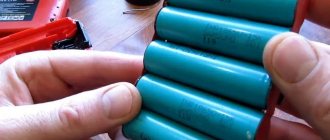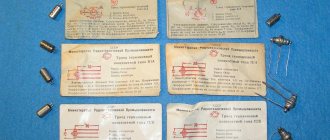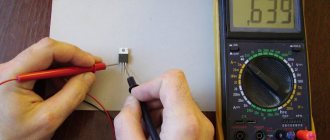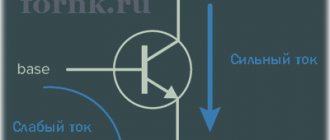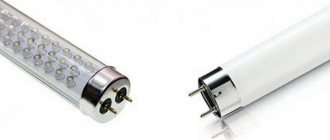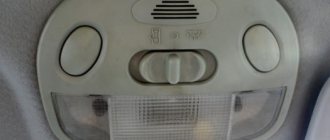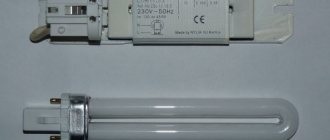Modern radio-electronic devices use a very wide range of various electronic devices. Sometimes the absence of one or more of these elements can slow down or even interrupt the installation or layout of a circuit.
Very often there are situations when it is necessary to replace one element with another . If we are talking about simply replacing one value of a resistor or capacitor with another, then the solution to the problem of replacement or selection of a replacement value is obvious. Less obvious are the replacements of radioelements that have specific properties inherent only to them.
Below we will consider the issues of replacing some special semiconductor devices with their equivalents made from more affordable elements.
In pulse technology, controlled and uncontrolled switching elements with a current-voltage characteristic with an N- or S-shaped section are widely used. These are avalanche transistors, gas dischargers, dinistors, thyristors, triacs, unijunction transistors, lambda diodes, tunnel diodes, injection field-effect transistors and other elements.
Bipolar avalanche transistors are widely used in relaxation pulse generators and various converters of electrical and non-electric quantities into frequency. It should be noted that such transistors are almost never produced specifically. In practice, ordinary transistors are used for these purposes in an unusual switching on or operating mode.
Equivalent to an avalanche transistor and dinistor
An avalanche transistor is a semiconductor device operating in avalanche breakdown mode. Such a breakdown usually occurs at a voltage exceeding the maximum permissible value.
Thermal breakdown (irreversible damage) of the transistor can be prevented by limiting the current through the transistor (by connecting a high-resistance load).
Avalanche breakdown of a transistor can occur in “direct” and “inverse” switching of the transistor. The avalanche breakdown voltage during inverse connection (the polarity of connecting the semiconductor device is opposite to the generally accepted, recommended one) is usually lower than for “direct” connection.
The base pin of the transistor is often not used (not connected to other circuit elements). In some cases, the base pin is connected to the emitter through a high-resistance resistor (hundreds of kOhms - units of MOhm). This allows you to regulate the avalanche breakdown voltage within certain limits.
In Fig. Figure 1 shows a diagram of an equivalent replacement of the “avalanche” transistor of the K101KT1 integrated chopper with its discrete analogues. It is interesting to note that upon closer examination, this circuit is identical to the equivalent circuit of a dinistor (Fig. 1), a thyristor (Fig. 2) and a unijunction transistor (Fig. 4).
Let us note in passing that the type of current-voltage characteristics of all these semiconductor devices has common characteristic features. Their current-voltage characteristics have an S-shaped section, a section with the so-called “negative” dynamic resistance. Thanks to this feature of the current-voltage characteristic, the listed devices can be used to generate electrical oscillations.
Rice. 1. Analogue of an avalanche transistor and dinistor.
Triacs
It is for such cases that the triac was invented. Let's talk about it and the principle of operation for dummies. The main difference between triacs and the elements discussed above is their ability to pass current in both directions. Essentially, these are two thyristors with common control, connected back-to-back (Figure 3 A).
This type of electronic components is used in the manufacturing sector, household appliances and power tools to continuously regulate current. This is the control of electric motors, heating elements, chargers.
In conclusion, I would like to say that both thyristors and triacs, while switching significant currents, have very modest sizes, while significant thermal power is released on their body. Simply put, they get very hot, so to protect the elements from overheating and thermal breakdown, they use a heat sink, which in the simplest case is an aluminum radiator.
Application of thyristor and triac: operating principle and control methods • World of Electrics
In this case, by changing the control voltage we can adjust the brightness of a light bulb or the temperature of the soldering iron tip, as well as the fan speed.
Expert opinion
It-Technology, Electrical power and electronics specialist
Ask questions to the “Specialist for modernization of energy generation systems”
Power regulator: triac and thyristor, indication systems and circuits The triac closes after changing the polarity between its terminals A1 and A2 or if the operating current value is less than the holding current Iud. Ask, I'm in touch!
Thyristor equivalent
Thyristors, dinistors and similar elements are capable of controlling large powers supplied to the load with very minor internal losses.
Thyristors are devices that have two stable states: a low conductivity state (no conductivity, the device is locked) and a high conductivity state (conductivity is close to zero, the device is open). Representatives of the thyristor class [A.I. Vishnevsky]:
- diode thyristors ( dinistors , diacs), having two terminals (anode and cathode), controlled by applying voltage to the electrodes with a high rate of increase or increasing the applied voltage to a value close to critical;
- triode thyristors ( thyristors , triacs), three-electrode elements, the control electrode of which serves to transfer the thyristor from a closed state to an open state;
- tetrode thyristors having two control electrodes;
- symmetrical thyristors - triacs having a five-layer structure. Sometimes this semiconductor device is called a semistor.
Diode thyristors (dinistors) , the range of which is not so large, differ mainly in the maximum permissible direct forward voltage in the closed state.
Thus, for dinistors of types KN102A, B, V, G, D, E, ZH, I (2N102A - I), the values of these voltages are, respectively, 5, 7, 10, 14, 20, 30, 40, 50 V with reverse current no more than 0.5 mA. The maximum permissible DC on-state current for these semiconductor devices is 0.2 A with a residual on-state voltage of 1.5 V.
In Fig. Figure 1 shows the equivalent circuit of a low-voltage dinistor. If we take R1 = R3 = 100 Ohm, we can obtain a dinistor with a controlled (using resistor R2) switching voltage from 1 to 25 V [Ya. Voitsekhovsky, R 11/73-40, R 12/76-29]. In the absence of this resistor and under the condition R1 = R3 = 5.1 kOhm, the switching voltage will be 9 B, and with R1 = R3 = 3 kOhm - 12 V.
An analogue of a thyristor with a p-p-p-p structure, described in the book by J. Wojciechowski, is shown in Fig. 2. The letter A indicates the anode; K - cathode; UE - control electrode. In the circuits (Fig. 1, 2) transistors of the KT315 and KT361 types can be used.
It is only necessary that the voltage supplied to the semiconductor device or its analogue does not exceed the maximum rated values. The table (Fig. 2) shows what values of R1 and R2 should be used as a guide when creating an analogue of a thyristor based on germanium or silicon transistors.
Rice. 2. Analogue of a thyristor.
In the breaks in the electrical circuit, shown in the diagram (Fig. 2) with crosses, you can include diodes that allow you to influence the type of current-voltage characteristic of the analogue. Unlike a conventional thyristor, its analogue (Fig. 2) can be controlled using an additional output - the control electrode EDOP, connected to the base of the transistor VT2 (top picture) or VT1 (bottom picture).
Typically, the thyristor is turned on by briefly applying voltage to the control electrode of the UE. When voltage is applied to the electrode, the thyristor, on the contrary, can be switched from the on state to the off state.
Opening principle using a control electrode
An equivalent representation of the p-npn structure in the form of two transistors is shown in Fig. 3.
Representing a thyristor in the form of two transistors of different conductivity types leads to the equivalent circuit shown in Fig. 1.4. It clearly explains the phenomenon of thyristor unlocking.
Let us set the current IGT through the control electrode of the thyristor, biased in the forward direction (voltage VAK positive), as shown in Fig. 4.
Since the IGT current becomes the base current of the npn transistor, the collector current of this transistor is equal to B1xIGT, where B1 is the current gain of transistor T1.
This current is also the base current of the pnp transistor, which leads to its unlocking. The collector current of transistor T2 is B1xB2xIGT and is summed with the current IGT, which maintains transistor T1 in the open state. Therefore, if the IGT drive current is large enough, both transistors will go into saturation.
The internal feedback circuit maintains the conductivity of the thyristor even if the initial current of the IGT control electrode disappears, while the anode current (1A) remains quite high.
A typical thyristor startup circuit is shown in Fig. 5
.
Fig.3. Splitting a thyristor into two transistors
Fig.4. Representation of a thyristor as a two-transistor circuit
Fig.5. Typical thyristor trigger circuit
Injection field effect transistor equivalent
An injection field-effect transistor is a semiconductor device with an S-shaped current-voltage characteristic. Such devices are widely used in pulse technology - in relaxation pulse generators, voltage-frequency converters, waiting and controlled generators, etc.
Such a transistor can be made by combining field-effect and conventional bipolar transistors (Fig. 5, 6). Not only the semiconductor structure can be modeled based on discrete elements.
Rice. 5. Analog of an injection field-effect transistor with a n-structure.
Rice. 6. Analog of an injection field-effect transistor with a p-structure.
Thyristor structure
A thyristor is a controlled three-electrode semiconductor device consisting of alternating four silicon layers of type p and n. A semiconductor device with a four-layer structure is shown in Fig. 1.
The extreme region of the p-structure, to which the positive pole of the power source is connected, is usually called the anode, and the extreme region n, to which the negative pole of this source is connected, is called the cathode.
Fig.1. Thyristor structure and designation
Equivalent to low voltage gas arrester
In Fig. Figure 7 shows a diagram of a device equivalent to a low-voltage gas discharger [PTE 4/83-127]. This device is a gas-filled cylinder with two electrodes, in which an electrical interelectrode breakdown occurs when a certain critical voltage value is exceeded.
The “breakdown” voltage for an analogue of a gas spark gap (Fig. 7) is 20 V. In the same way, an analogue of, for example, a neon lamp can be created.
Rice. 7. Analogue of a gas discharger - equivalent replacement circuit.
Thyristor shutdown
The thyristor will go into the closed state if no signal is applied to the control electrode of the open thyristor, and its operating current drops to a certain value called the holding current (hypostatic current).
The thyristor will turn off, in particular, if the load circuit was open (Fig. 6a) or the voltage applied to the external circuit changed polarity (this happens at the end of each half-cycle of the alternating supply voltage).
Fig.6. Methods for turning off a thyristor
When the thyristor operates at constant current, switching off can be done using a mechanical switch.
Connected in series with the load, this switch is used to disconnect the operating circuit.
A switch connected in parallel to the main electrodes of the thyristor (Fig. 6b) shunts the anode current, and the thyristor goes into the closed state. Some thyristors turn on again after the switch is opened. This is explained by the fact that when the switch is opened, the parasitic capacitance of the p-n junction of the thyristor is charged, causing interference.
Therefore, they prefer to place the switch between the control electrode and the cathode of the thyristor (Fig. 1.6c), which guarantees correct shutdown by cutting off the holding current. At the same time, the p-n junction corresponding to diode D2 from the thyristor equivalent circuit with three diodes is reverse-biased (Fig. 2).
In Fig. 6a-e show various options for thyristor shutdown circuits, including those previously mentioned. Others are usually used when it is necessary to turn off the thyristor using an additional circuit. In these cases, the mechanical switch can be replaced by an auxiliary thyristor or a key transistor, as shown in Fig. 7.
Fig.7. Classic thyristor shutdown circuits using an additional circuit
Equivalent replacement of lambda diodes
Semiconductor devices such as lambda diodes and tunnel diodes . The current-voltage characteristics of these devices have an N-shaped section.
Lambda diodes and tunnel diodes can be used to generate and amplify electrical signals. In Fig. 8 and fig. Figure 9 shows circuits simulating lambda di-od [RTE 9/87-35].
In practice, generators often use the circuit shown in Fig. 9 [PTE 5/77-96]. If a controlled resistor (potentiometer) or transistor (field-effect or bipolar) is connected between the drains of the field-effect transistors, then the type of current-voltage characteristic of such a “lambda diode” can be controlled within wide limits: adjust the generation frequency, modulate high-frequency oscillations, etc.
Rice. 8. Analog of a lambda diode.
Rice. 9. Analog of a lambda diode.
Thyristors and triacs – RadioRadar
Schematic diagram of the regulator based on the BT136-600 triac
The given circuit of the power regulator on a triac is designed for a fairly large load current.
If you do not have the necessary parts and board to assemble a power regulator on a MAC97A6 triac, you can buy a complete kit for assembling it in our store.
Expert opinion
It-Technology, Electrical power and electronics specialist
Ask questions to the “Specialist for modernization of energy generation systems”
Thyristor structure In addition to operating in relay mode in a thermostat or photosensitive switch, control systems have been developed and are widely used that operate on the principle of phase control of the load voltage, or, in other words, smooth regulators. Ask, I'm in touch!
How to check the functionality of a triac?
You can find several methods online that describe the testing process using a multimeter; those who described them, apparently, have not tried any of the options themselves. In order not to be misleading, you should immediately note that testing with a multimeter will not be possible, since there is not enough current to open the symmetrical SCR. Therefore, we are left with two options:
- Use a pointer ohmmeter or tester (their current strength will be sufficient to trigger).
- Collect a special circuit.
Algorithm for checking with an ohmmeter:
- We connect the probes of the device to terminals T1 and T2 (A1 and A2).
- Set the multiplicity on the ohmmeter x1.
- We carry out a measurement, a positive result will be infinite resistance, otherwise the part is “broken” and can be gotten rid of.
- We continue testing, to do this we briefly connect pins T2 and G (control). The resistance should drop to about 20-80 ohms.
- Change the polarity and repeat the test from steps 3 to 4.
If during the test the result is the same as described in the algorithm, then with a high probability it can be stated that the device is operational.
Note that the part being tested does not have to be dismantled; it is enough to just turn off the control output (naturally, having first de-energized the equipment where the part that raises doubt is installed).
It should be noted that this method does not always allow reliable testing, with the exception of testing for “breakdown”, so let’s move on to the second option and propose two circuits for testing symmetrical thyristors.
We will not give a circuit with a light bulb and a battery in view of the fact that there are enough such circuits on the network. If you are interested in this option, you can look at it in the publication on testing thyristors. Let's give an example of a more effective device.
Circuit of a simple tester for triacs
Designations:
- Resistor R1 – 51 Ohm.
- Capacitors C1 and C2 – 1000 µF x 16 V.
- Diodes - 1N4007 or equivalent, installation of a diode bridge, for example KTs405, is allowed.
- HL bulb – 12 V, 0.5 A.
You can use any transformer with two independent 12 Volt secondary windings.
Verification algorithm:
- Set the switches to their original position (corresponding to the diagram).
- We press SB1, the device under test opens, as indicated by the light bulb.
- Press SB2, the lamp goes out (the device is closed).
- We change the mode of the SA1 switch and repeat pressing SB1, the lamp should light up again.
- We switch SA2, press SB1, then change the position of SA2 again and press SB1 again. The indicator will turn on when the shutter hits minus.
Now let's look at another scheme, only universal, but also not particularly complicated.
Circuit for testing thyristors and triacs
Designations:
- Resistors: R1, R2 and R4 – 470 Ohm; R3 and R5 – 1 kOhm.
- Capacities: C1 and C2 – 100 µF x 10 V.
- Diodes: VD1, VD2, VD5 and VD6 – 2N4148; VD2 and VD3 – AL307.
A 9V battery, Krona type, is used as a power source.
Read also: Reverse 3-phase motor circuit
Testing of SCRs is carried out as follows:
- Switch S3 is moved to the position as shown in the diagram (see Fig. 6).
- Briefly press button S2, the element under test will open, which will be signaled by the VD LED
- We change the polarity by setting switch S3 to the middle position (the power is turned off and the LED goes out), then to the bottom.
- Briefly press S2, the LEDs should not light up.
If the result corresponds to the above, then everything is in order with the tested element.
Now let's look at how to check symmetrical thyristors using the assembled circuit:
- We carry out steps 1-4.
- Press the S1 button - the VD LED lights up
That is, when you press the S1 or S2 buttons, the VD1 or VD4 LEDs will light up, depending on the set polarity (the position of the S3 switch).
VRemont.su - repair of photo video equipment, household appliances, review and analysis of the service sector market
The thyristor is ideal for regulating AC power in every way except for one thing: it is a half-wave device, which means that even when fully conducting, only half the power is used. It is possible to connect two thyristors in parallel towards each other, as shown in Fig. 1, to provide a two-half-wave mode of operation, however, this requires supplying trigger pulses to the control electrodes from two isolated but synchronous sources, as can be seen from the figure.Fig. 1 A full-wave regulator can be built using two thyristors. To isolate pulse sources from the mains voltage, optocouplers are used.
The most useful device for practical AC power control is the bidirectional thyristor or triac. As can be seen in Fig.2. A triac can be considered as two inverse-parallel thyristors controlled from a single signal source. Triacs are such flexible devices that they can be switched into a conducting state by either a positive or negative trigger pulse, regardless of the instantaneous polarity of the AC voltage source. The names cathode and anode become meaningless for a triac; The terminal closest to the control electrode was called, without further ado, main terminal 1 (MT1), and the other - main terminal 2 (MT2). The triggering pulse is always applied relative to the MT1 pin in the same way as in the case of a thyristor it is applied relative to the cathode.
Fig2. Triac: (a) structure, (b) symbol.
Typically, a starting current of 20 mA is sufficient to switch a triac rated for currents up to 25 A, and one of the simplest examples of its application is a “solid-state relay”, in which a small starting current is used to control a large load current (Fig. 3). The SW1 key can be a reed switch, a sensitive thermal relay, or any contact pair rated at 50 mA; the current in the load circuit is limited only by the parameters of the triac. It is useful to note that resistor R1 in the starting circuit is under mains voltage only when the triac is turned on; as soon as the triac is turned on, the potential difference across resistor R1 drops to about one volt, so a half-watt resistor is sufficient.
Fig. 3 A simple “solid-state relay” based on a triac.
Very common uses of a triac are dimming a lamp or controlling the speed of a motor. Figure 4 shows such a diagram. The temporal position of the trigger pulses is set by the RC phase shifter; Potentiometer R2 adjusts the brightness of the lamp, while resistor R1 simply limits the current when the potentiometer is set to the minimum resistance position. The trigger pulses themselves are generated by a dinistor, that is, a bidirectional trigger diode. A dinistor can be thought of as a low-power thyristor without a control electrode with a low avalanche breakdown voltage (about 30 V). When the potential difference across capacitor C1 reaches the breakdown level in the dinistor, an instantaneous discharge pulse of the capacitor turns on the triac.
Fig. 4 The simplest circuit for adjusting the brightness of a lamp using a triac with phase control.
It is easy to make an automatic photoelectric lamp switch by connecting an ORP12 photocell (light-dependent resistor) in parallel with capacitor C1. The resistance of the photocell in the dark is high, about 1 MOhm, but in daylight it drops to several kiloohms so that the triac cannot ignite and the lamp is turned off. If manual adjustment is not required in the circuit breaker, then resistor R2 can be replaced with a short circuit.
Figure 5 shows how a triac controls power in the load by cutting off the initial part of each half-cycle. The duration of the missed part depends on the phase delay of the starting pulse, which is determined by resistance R1+R2 and capacitance C1. In the simplest control circuit in Fig. 4, the phase shift cannot be more than 90°, since only one RC chain is used. Therefore, such a circuit is a poor regulator at low power, since it can experience unexpected jumps from the off state to full power.
A more advanced diagram is shown in Fig. 6; inclusion of an additional RC circuit (R3C3) gives greater phase shift for better control at low power. Further improvements consist of the introduction of the following elements: (a) a damper with a time constant R4C4 to prevent erroneous switching from the back-emf. inductive load and (b) RF filter L1C1 for noise suppression. The last element should always be introduced into a triac or thyristor circuit that operates on the principle of “cutting off part of the oscillation,” since rapid switching on and off can create serious radio interference in the supply network.
Fig. 5 Voltage shape across the load in a triac regulator with a gradual increase in the phase shift.
There are a large number of different triacs and thyristors that are widely used in household appliances. As with rectifier diodes, catalogs and reference data can be consulted to select a device with the desired voltage and current ratings.
Fig. 6 Triac power regulator with a wide adjustment range and built-in noise suppression.
Most manufacturers produce suitable dinistors, but there are also devices called quadracs, which combine a triac and a dinistor.
Figure 7 shows the housings and pinouts of common triacs. If the triac is to be used at its full permissible power, then it must be secured to the heat sink.
Suppressing RF interference generated by phase-controlled triac or thyristor regulators becomes more difficult and expensive at higher load currents. In electric heaters and other loads with high inertia, it is possible to reduce interference by skipping an integral number of half-cycles each time. This avoids sudden changes in current that cause radio frequency interference. This method is called intermittent starting or integer-period control. This method is generally not suitable for controlling lamp brightness due to flicker. To implement control with an integer number of periods, microcircuits such as the SL441, which turn on at zero voltage, are suitable. They determine when the network voltage crosses the zero level and ensure that the triac is triggered from a sensor whose resistance changes, for example, from a thermistor.
Fig. 7 Cases of common triacs: (a) T066 case, (b) bolted fasteners, (c) T0220 plastic case.
Triac power
Now that we already know quite a lot about triacs, it’s time to move on to the technical part. How? Already? Yeah, you're already ready for this. So, the most important aspect that worries all buyers of this wonderful device is power. Of course, this usually means a whole set of technical characteristics of a triac. We will talk about them. Note that we will analyze the characteristics using the example of a fairly popular model - BT139-800.
First let's find out. What are the technical specifications anyway? What we will be most concerned about is:
- the highest voltage possible
- the highest voltage when the triac is open
- the voltage at which the triac is unlocked
- the smallest current at which the triac opens
- temperatures at which the triac operates
- response time
Yeah, it seems like we’ve already talked about all this, so it’s not that difficult. Fine. Now about each characteristic in a little more detail.
Response time
The response speed of the triac is also a very important parameter. Why? When there are many such triacs in a circuit and if each one takes a long time to operate, then a large device will take a very long time to respond to each command or may even not be able to work at all.
The current also has its own speed, and if a bunch of others are superimposed on its delay, then the device can become very slow, so you also need to pay attention to this. Our triac operates on average in 2 microseconds and this is a very good result. Formally, this is the time that will pass from the moment when the triac starts to open and is already open.
Temperature is also important
Triacs, of course, operate at fairly common temperatures for us. However, when placing it in critical conditions, it will be better if this range is very wide. Our triac operates at temperatures from MINUS 40 to PLUS 125 degrees Celsius. In ordinary life, this range is optimal, so there is nothing to add here.
The highest possible voltage
In the BT139-800 triac this is 800 volts and in other models this parameter may differ. Do not assume that this is the voltage at which the triac works perfectly. No, on the contrary, this is a theoretical voltage from which the triac will not fail. That is, under ideal conditions for a particular model, this triac will still draw such voltage in the circuit, but if it is exceeded, there is almost no chance of further operation. Go ahead.
Triac control via transistor
A triac (“triac” in US terminology) is a bidirectional symmetrical thyristor. Triacs are very convenient for key control systems in AC circuits. As a result, they practically replaced thyristors from household appliances (washing machines, vacuum cleaners, etc.).
A triac does not have an anode and a cathode. Its three outputs are called: UE (control electrode), SEU (power electrode located closer to the UE), SE (power electrode at the base of the device) [2-197]. There are also similar foreign names adopted in triacs, respectively, “G” (Gate), “T1” (Main Terminal 1) and “T2” (Main Terminal 2).
The triac, depending on the design, can be opened by both positive and negative pulses at the output of the UE. The branches of the current-voltage characteristic are symmetrical, so the current through the power electrodes can be both inflowing and outflowing. In total, there are four operating modes in quadrants 1…4 (Fig. 2.105).
Rice. 2.105. Operating modes of triacs (triacs).
The first to be developed were four-quadrant triacs or, in other words, 4Q-TpnaKM. For normal operation, they require the introduction into the circuit of damper LS circuits (100 Ohm, 0.1 MK F), which are installed parallel to the power electrodes of the SEU and SE. In this simple way, the rate of voltage rise through the triac is reduced and false alarms are eliminated at elevated temperatures and significant inductive or capacitive loads.
Recent technological advances have made it possible to create three-quadrant triacs or, in other words, 3Q triacs. They, unlike “4Q” triacs, operate in three out of four quadrants and do not require IC circuits. Typical parameters of 3Q-TpnaKOB Hi-Com BTA208...225 from Philips: maximum switching voltage 600...800 V, power section current 8...25 A, gate unlocking current (GEC) 2...50 mA, small-sized SMD housing.
Schemes for connecting triacs to MK can be divided into two groups: without isolation from the 220 V network (Fig. 2.106, a...r) and with galvanic isolation (Fig. 2.107, a...l).
Some comments. The types of triacs indicated on the diagrams are the same, mainly KU208x, BTxxx, MACxxx. This was done specifically to focus attention on the circuit design of the low-voltage control part, since it is closest to the MK. In practice, you can use other types of triacs, monitoring their output power and the amplitude of the control current.
As a rule, damper chains in the power section are absent in the diagrams. This is a simplification to avoid cluttering the figures, since the load resistance RH is assumed to be purely resistive in nature. In real life, damping is necessary for 4Q triacs if the load has a significant inductive or capacitive component.
Rice. 2.106. Schemes for connecting triacs to MK without galvanic isolation.
a) A HIGH level at the output of the MK opens the transistor VT1, through which the triac VS1 is turned on. Varistor RU1 protects the triac from voltage surges, starting from a threshold of 470 V (range 423...517 V). This is relevant for the inductive nature of the load jRH;
b) similar to Fig. 2.106, a, but with a different polarity of the signal at the MK output and with a transistor VT1 of a different structure, which acts as a voltage inverter. Due to the low resistance of resistor R2, noise immunity increases. The resistance of resistor R2 is selected according to the same criteria as for thyristor circuits;
Rice. 2.106. Schemes for connecting triacs to MK without galvanic isolation.
c) high-voltage transistor GU2 closes the diagonal diode bridge VD1 at a LOW level on the MK line. Transistor VT1 at the moment of restart MK is in the open state due to resistor R1, while the triac VS1 closes and no current flows through the load RH;
d) direct control of triac VS1 from one or more MK outputs. Paralleling of lines is used when the control current is insufficient (shown by the dotted line). The current through the RH load is no more than 150 mA. Possible replacements: VS1 - MAC97A8, VD2 - KC147A.
a) triac VS1 turns on/off in the presence/absence of 50...100 kHz pulses generated from the MK output. The insulating transformer T1 is wound on a ring of N30 ferrite and contains 15 turns in winding I, 45 turns of PEV-0.2 wire in winding II;
b) a simple transformer isolation circuit. Triac VS1 is turned on by short pulses from the MK output. The control current depends on the transformation ratio 77;
Rice. 2.107. Schemes of galvanic isolation of MK from triacs.
c) isolation transformer T1 is wound on a ferrite ring M1000HM with dimensions K20xl2x6 and contains 60 turns in winding I, and 120 turns of PEV-0.2 wire in winding II. Chain R3, C1 accumulates energy for pulse switching of transistor K77;
d) if frequent switching on/off of the load is not required, then relay K1 can be used for galvanic isolation. Its contacts must withstand an alternating voltage of 220 V without breakdown. In some circuits, the current-limiting resistor R3 is short-circuited;
e) the contacts of the reed switch SF1 close when current flows through the inductor L1, which is wound on its body. Advantage: ultra-high insulation resistance;
